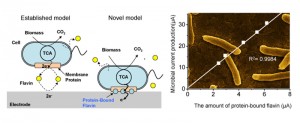Uncovering the mechanisms of microbial electricity generation Novel model 1000-times more efficient than current model

Bacteria transport electrons to extracellular solid materials, such as Fe(III)- and Mn(IV)-oxide insoluble minerals and even artificial electrodes. This is called extracellular electron transport (EET), and provides a central driving force for microbial fuel cells capable of producing electricity by decomposing biomass and/or organic wastewater. For the EET process, it was thought that microbes transport electrons by the shuttling process of a redox mediator, i.e. first microbes synthesize an electron-carrier flavin molecule, second the flavin receives electrons from the microbe, and third the flavin molecule diffuses to the electrode surface to terminate the EET.

© Akihiro Okamoto. Generation of protein-bound flavin directly correlated with microbial current production, demonstrating the bound flavin is the most efficient electron transport pathway.
In this study, researchers from the University of Tokyo (Assistant Prof. Okamoto, Prof. Hashimoto, and Assistant Prof. Nakamura) and University of Southern California (Prof. Kenneth H. Nealson) discovered a novel bacterial ability to transport electrons without the shuttling process. Assistant Prof. Okamoto discovered by using in vivo electrochemical techniques that the EET process is mediated by a flavin molecule associated with a membrane-bound protein. This protein-bound flavin could enhance the efficiency of the EET process more-than 1,000 times compared with the shuttling model. This finding will contribute to improving the power-output of microbial fuel cells, and also the development of technology for the inhibition of microbial iron corrosion.
Paper
Akihiro Okamoto, Kazuhito Hashimoto, Kenneth H. Nealson, Ryuhei Nakamura,
“Rate Enhancement of Bacterial Extracellular Electron Transport Involves Bound Flavin Semiquinones”,
Proceedings of the National Academy of Sciences doi: 10.1073/pnas.1220823110.
Article link
Links
Graduate School of Engineering
Department of Applied Chemistry, Graduate School of Engineering
Hashimoto Laboratory, Department of Applied Chemistry, Graduate School of Engineering







